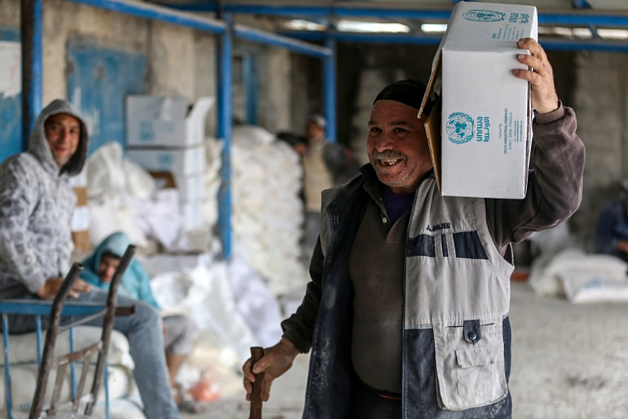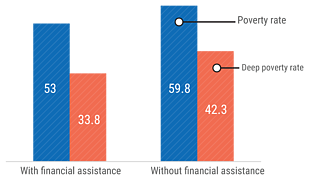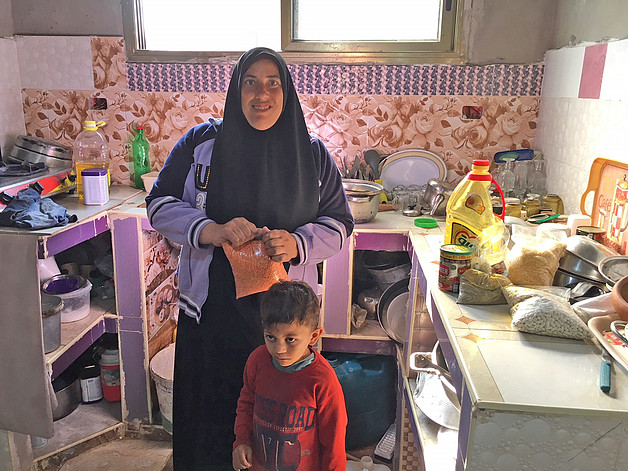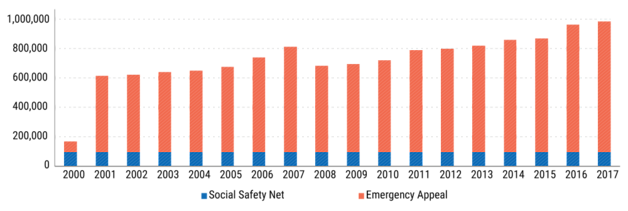53 per cent of Palestinians in Gaza live in poverty, despite humanitarian assistance
A 14 percentage point increase since 2011
The findings of a Household Expenditure and Consumption Survey, released by the Palestinian Central Bureau of Statistics (PCBS) in May, show a significant increase in poverty rates in the Gaza Strip: from 38.8 per cent in 2011 (the previous time poverty was measured) to 53 per cent by the end of 2017, which is the equivalent to around 1.01 million people, including over 400,000 children.[1] This means that poverty increased by more than 14 percentage points in a period of six years.

Poor people are defined as those living on less than US$4.6 per day, including social assistance and transfers, which is estimated by PCBS as the minimum to cover basic household needs (shelter, clothing and food), in addition to basic healthcare, education and transportation.[2] Moreover, nearly two thirds of the poor, or about 656,000 people, are considered to be living in “deep poverty”, which means on less than $3.6 per day, the minimum to cover only shelter, clothing and food needs.
More than half (53.6 per cent) of those who reported that their main source of income is social assistance and transfers were found to be poor (after taking into account that income), compared to 29 per cent of those who rely on private sector salaries and 26 per cent of those relying on public sector salaries. According to the findings, without social assistance and transfers, by 2017 the poverty rate in Gaza would have reached nearly 60 per cent, and deep poverty more than 42 per cent.

Another finding confirming the fragility of the situation is the share of food in the total household consumption, which in the Gaza Strip reached almost 35 per cent. The higher this share is, the lower the standard of living, as fewer resources are available for other needs.
The increase in poverty in Gaza, as reflected in PCBS data, has been driven by the extreme volatility of its economy, characterized by short periods of growth followed by prolonged and deep recessions. This has resulted in some of the highest unemployment rates in the world: in the first quarter of 2018 it reached 49.1 per cent. Key factors affecting these dynamics include the longstanding Israeli blockade, exacerbated by the internal Palestinian divide, recurrent outbreaks of hostilities, and the chronic energy crisis.
Food insecurity
As confirmed by the PCBS survey, food insecurity in Gaza is primarily caused by a lack of economic access to food, i.e poverty, rather than by the unavailability of food in the marketplace. As a result, the United Nations, through UNRWA and WFP, has increased its food assistance caseload. However, the continuation of this assistance is being currently at risk due to a severe funding shortage.
UNRWA currently provides food assistance to more than 996,000 Palestinian refugees in Gaza, who do not have the financial means to cover their basic food needs, through its Emergency Food Assistance program and its Social Safety Net program.
The percentage of individuals receiving UNRWA food assistance has increased from less than 10 per cent of the refugee population in Gaza in 2000, to approximately 70 per cent in 2017 (see chart below). UNRWA provides eligible refugee families, on a quarterly basis, a food basket which covers the bulk of the daily caloric needs of beneficiaries.[3]
Moreover, UNRWA internal records have revealed a significant increase in the number of refugees in Gaza whose status has been downgraded from absolute to abject poverty: 46 per cent of those originally assessed as absolute poor are now classified as abject poor.[4]
UNRWA Gaza field office food beneficairies
Only 11 per cent of the originally assessed abject poor families have been reclassified as absolute poor due to an improvement in their situation.
A further 245,000 food-insecure non-refugees, all falling below the deep poverty line, are targeted by WFP with food and cash-based transfers. WFP’s monitoring in April showed an increase in people’s negative strategies in trying to cope with a deteriorating situation. Debt is spiraling at a faster rate than ever given the decline in people’s income and purchasing power. All WFP beneficiaries surveyed since the beginning of the year live with less than a dollar per day and 70 per cent are heavily indebted, with an average debt of $4,500: $2,900 for electricity and water, $260 for groceries, and $1,340 worth of credit from friends and relatives.
The 2018 Humanitarian Response Plan appealed for $224.8 million to cover needs in food security sector in the Gaza Strip. As of the end of May 2018, partners have received $37.7 million, or 16.7 per cent of the requirement. Despite the significant funding shortfall, UNRWA continues to prioritize food assistance to vulnerable refugees and to date timely contributions from various donors have made it possible to ensure continuity. Efforts are underway at various levels to mobilize funding from various donors to ensure that food needs are covered until the end of the year. While WFP has so far maintained its food assistance program, if no additional funding is received in the coming weeks it will be forced to suspend it as early as of July.
Struggling to feed the family: Sanuora’s story
Sanuora, aged 35, is a divorced single mother, living in very poor conditions at her parents’ house in Beit Lahiya, North Gaza, and struggling to provide for her six children. She is a beneficiary of WFP’s food assistance program.
For Sanuora, finding a job is virtually impossible due to her lack of education and formal work experience in an area with one of the highest unemployment rates in the world. She was forced to drop out of school at 11. As a divorced mother, she tries to make ends meet with the help of friends and relatives, and by depending on external assistance. She has enlisted in multiple national social assistance programs. She receives food, cash and medical support and relies on a share of the small income her brother makes as a casual labourer in construction. With the constant deterioration of the already dire living conditions in Gaza, Sanuora can no longer rely on the generosity of friends and relatives.

“I have accumulated too many debts that I need to repay each month. We had to borrow 5,000 New Israeli Shekels (NIS) (1,500 dollars) from relatives to build an extra room to accommodate me and my children. I have 3,000 NIS (850 dollars) of food debts to a few shop-keepers and owe countless shekels to the local electricity and water supply company”.
The lack of electricity has also forced Sanuora to focus on purchasing dry goods instead of dairy products, as she can no longer store food in her refrigerator nor use her makeshift oven. She has resorted to cooking over a fire as gas has become too expensive.
“Every day is worse than the previous one. My brother stopped working and my friends and family can no longer afford to support me. I had no choice but to take on additional loans to avoid my children sleeping on an empty stomach”.
Each month, she uses the cash assistance she receives from the national social transfer scheme to repay her longstanding dues. WFP’s food assistance has been of paramount importance for Sanuora to feed her household and buy other essentials, like clothes and soap.
* This article was contributed by The Food Security Sector
[1] Palestinian Central Bureau of Statistics, 1028. Main Findings of Living Standards in Palestine (Expenditure, Consumption and Poverty), 2017. Poverty rates in the oPt as a whole recorded an increase from 25.8 per cent in 2011 to 29.2 per cent in 2017. In the West Bank, poverty rates stood at 17.8 per cent, up from 13.9 per cent in 2011.
[2] This income level applies for a household of two adults and three children living with less than NIS 2,470 per month, which are considered poor, or with less than NIS 1,974 per month, which are considered deep poor.
[3] Eligibility for emergency food assistance is determined based on the results of a Poverty Assessment Survey (PAS) which UNRWA social workers conduct on a biannual basis through home visits. This system captures essential household characteristics such as age, gender, housing conditions, household composition, asset ownership and employment status. It also takes into account vulnerabilities, for example, cases of refugees who are unable to access emergency food assistance through regular channels: wives in polygamous marriages, divorced women, and separated or abandoned women. Eligible individuals receive food baskets containing flour, rice, sugar, sunflower oil, whole milk, chickpeas, lentils and canned sardines (In 2017, UNRWA distributed 6,538,850 MT of these items).
[4] UNRWA defines abject poor refugees as those living below the abject-poverty line of $1.74 per person per day. While it defines absolute poor refugees as those living between the abject-poverty line and the absolute poverty line of $3.87 per person per day.











